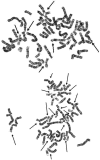Current insights into inherited bone marrow failure syndromes
- PMID: 25210520
- PMCID: PMC4155177
- DOI: 10.3345/kjp.2014.57.8.337
Current insights into inherited bone marrow failure syndromes
Abstract
Inherited bone marrow failure syndrome (IBMFS) encompasses a heterogeneous and complex group of genetic disorders characterized by physical malformations, insufficient blood cell production, and increased risk of malignancies. They often have substantial phenotype overlap, and therefore, genotyping is often a critical means of establishing a diagnosis. Current advances in the field of IBMFSs have identified multiple genes associated with IBMFSs and their pathways: genes involved in ribosome biogenesis, such as those associated with Diamond-Blackfan anemia and Shwachman-Diamond syndrome; genes involved in telomere maintenance, such as dyskeratosis congenita genes; genes encoding neutrophil elastase or neutrophil adhesion and mobility associated with severe congenital neutropenia; and genes involved in DNA recombination repair, such as those associated with Fanconi anemia. Early and adequate genetic diagnosis is required for proper management and follow-up in clinical practice. Recent advances using new molecular technologies, including next generation sequencing (NGS), have helped identify new candidate genes associated with the development of bone marrow failure. Targeted NGS using panels of large numbers of genes is rapidly gaining potential for use as a cost-effective diagnostic tool for the identification of mutations in newly diagnosed patients. In this review, we have described recent insights into IBMFS and how they are advancing our understanding of the disease's pathophysiology; we have also discussed the possible implications they will have in clinical practice for Korean patients.
Keywords: Bone marrow failure syndromes; Diamond-Blackfan anemia; Fanconi anemia; Severe congenital neutropenia; Shwachman-Diamond syndrome.
Conflict of interest statement
No potential conflicts of interest relevant to this article were reported.
Figures



Similar articles
-
The Molecular and Genetic Mechanisms of Inherited Bone Marrow Failure Syndromes: The Role of Inflammatory Cytokines in Their Pathogenesis.Biomolecules. 2023 Aug 16;13(8):1249. doi: 10.3390/biom13081249. Biomolecules. 2023. PMID: 37627314 Free PMC article. Review.
-
Classical inherited bone marrow failure syndromes with high risk for myelodysplastic syndrome and acute myelogenous leukemia.Semin Hematol. 2017 Apr;54(2):105-114. doi: 10.1053/j.seminhematol.2017.04.004. Epub 2017 Apr 7. Semin Hematol. 2017. PMID: 28637614 Review.
-
Genetics and genomics of bone marrow failure syndrome.Blood Res. 2022 Apr 30;57(S1):86-92. doi: 10.5045/br.2022.2022056. Blood Res. 2022. PMID: 35483932 Free PMC article. Review.
-
Inherited bone marrow failure syndromes: phenotype as a tool for early diagnostic suspicion at a major reference center in Mexico.Front Genet. 2024 Jan 24;14:1293929. doi: 10.3389/fgene.2023.1293929. eCollection 2023. Front Genet. 2024. PMID: 38327701 Free PMC article.
-
Frequency and natural history of inherited bone marrow failure syndromes: the Israeli Inherited Bone Marrow Failure Registry.Haematologica. 2010 Aug;95(8):1300-7. doi: 10.3324/haematol.2009.018119. Epub 2010 Apr 30. Haematologica. 2010. PMID: 20435624 Free PMC article.
Cited by
-
The Stomatological Complications of Diamond-Blackfan Anemia: A Case Report.Clin Med Res. 2016 Jun;14(2):97-102. doi: 10.3121/cmr.2015.1305. Epub 2016 Feb 10. Clin Med Res. 2016. PMID: 26864506 Free PMC article.
-
Single-cell RNA Sequencing Reveals Novel Cellular Factors for Response to Immunosuppressive Therapy in Aplastic Anemia.Hemasphere. 2023 Oct 27;7(11):e977. doi: 10.1097/HS9.0000000000000977. eCollection 2023 Nov. Hemasphere. 2023. PMID: 37908861 Free PMC article.
-
Identification of potential pathogenic genes associated with osteoporosis.Bone Joint Res. 2017 Dec;6(12):640-648. doi: 10.1302/2046-3758.612.BJR-2017-0102.R1. Bone Joint Res. 2017. PMID: 29203636 Free PMC article.
-
Neonatal manifestations of inherited bone marrow failure syndromes.Semin Fetal Neonatal Med. 2016 Feb;21(1):57-65. doi: 10.1016/j.siny.2015.12.003. Epub 2015 Dec 24. Semin Fetal Neonatal Med. 2016. PMID: 26724991 Free PMC article. Review.
-
Clinical usefulness of next-generation sequencing-based target gene sequencing in diagnosis of inherited bone marrow failure syndrome.Ann Hematol. 2025 May;104(5):2693-2706. doi: 10.1007/s00277-025-06392-0. Epub 2025 May 13. Ann Hematol. 2025. PMID: 40358701 Free PMC article.
References
-
- Kook H. Fanconi anemia: current management. Hematology. 2005;10(Suppl 1):108–110. - PubMed
-
- Bessler MP, Lin DC, Wilson DB. Inherited bone marrow failure syndromes. In: Orkin SH, Ginsburg D, editors. Nathan and Oski's hematology of infancy and childhood. 7th ed. Philadelphia, PA: WB Saunders; 2008. pp. 351–360.
-
- Alter BP. Fanconi's anaemia and its variability. Br J Haematol. 1993;85:9–14. - PubMed
Publication types
LinkOut - more resources
Full Text Sources
Other Literature Sources

